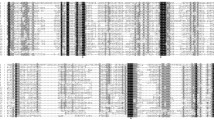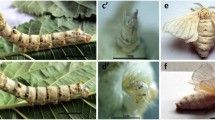Abstract
The will die slowly (wds) gene coding for a WD-repeat protein with seven repeats has been characterized in Drosophila melanogaster. In this paper, the wds gene was isolated and characterized from the Chinese oak silkworm, Antheraea pernyi (Lepidoptera: Saturniidae). The obtained 1733 bp cDNA sequence contains an open reading frame of 1041 bp encoding a polypeptide of 346 amino acids, with 85% sequence identity to that from D. melanogaster. RT-PCR analysis showed that the wds gene was transcribed during four developmental stages and in all the tissues tested, consistent with the result observed in Bombyx mori based on EST resources and genome-wide microarray information. The mRNA expression level of the A. pernyi wds gene was not significantly down- or up- regulated under temperature stress compared to the control, indicating that it may be not involved in temperature stress tolerance. In search of database, the wds protein homologues were found in various kinds of eukaryotes, including fungi, plants, invertebrates and vertebrates, with 50–93% amino acid sequence identities between them, suggesting that they are highly conserved during the evolution of eukaryotes. Phylogenetic analysis based on the wds protein homologue sequences clearly separated the known fungi, plants, invertebrates and vertebrates, consistent with the topology tree on the classical systematics, suggesting the potential value of wds protein in eukaryotic phylogenetic inference. In vertebrates, two apparent types of the wds proteins were also defined by sequence alignment and phylogenetic analysis.





Similar content being viewed by others
References
Komachi K, Johnson AD (1997) Residues in the WD repeats of Tup1 required for interaction with α-2. Mol Cell Biol 17:6023–6028
Tyers M, Jorgensen P (2000) Proteolysis and the cell cycle: with this RING I do thee destroy. Curr Opin Genet Dev 10:54–64
Neer EJ, Smith CJ, Nambudripad R, Smith TF (1994) The ancient regulatory-protein family of WD-repeat proteins. Nature 371:297–300
Hollmann M, Simmerl E, Schäfer U, Schäfer MA (2002) The essential Drosophila melanogaster gene wds (will die slowly) codes for a WD-repeat protein with seven repeats. Mol Genet Genomics 268:425–433
Judd BH, Shen MW, Kaufman TC (1972) The anatomy and function of a segment of the X chromosome of Drosophila melanogaster. Genetics 71:139–156
Chou TB, Perrimon N (1992) Use of a yeast site-specific recombinase to produce female germline chimeras in Drosophila. Genetics 131:643–653
Huang YJ, Kobayashi J, Yoshimura T (2002) Genome mapping and gene analysis of Antheraea pernyi nucleopolyhedrovirus for improvement of baculovirus expression vector system. J Biosci Bioeng 93:183–191
Li YP, Xia RX, Wang H, Li XS, Liu YQ, Wei ZJ, Lu C, Xiang ZH (2009) Construction of a full-length cDNA library from Chinese oak silkworm pupa and identification of a KK42-binding protein gene in relation to pupa-diapause termination. Int J Biol Sci 5(5):451–457
Duan J, Li RQ, Cheng DJ, Fan W, Zha XF, Cheng TC, Wu YQ, Wang J, Mita K, Xiang ZH, Xia QY (2010) SilkDB v2.0: a platform for silkworm (Bombyx mori) genome biology. Nucleic Acids Res 38(suppl 1):D453–D456. doi:10.1093/nar/gkp801
Wu S, Xuan ZX, Li YP, Li Q, Xia RX, Shi SL, Qin L, Wang ZD, Liu YQ (2010) Cloning and characterization of the first actin gene in Chinese oak silkworm, Antheraea pernyi. Afr J Agric Res 5(10):1095–1100
Thompson JD, Gibson TJ, Plewniak F, Jeanmougin F, Higgins DG (1997) The CLUSTAL_X windows interface: flexible strategies for multiple sequence alignment aided by quality analysis tools. Nucleic Acids Res 25:4876–4882
Tamura K, Dudley J, Nei M, Kumar S (2007) MEGA4: Molecular Evolutionary Genetics Analysis (MEGA) software version 4.0. Mol Biol Evol 24:1596–1599
Saitou N, Nei M (1987) The neighbor-joining method: a new method for reconstructing phylogenetic trees. Mol Biol Evol 4:406–425
Smith TF, Gaitatzes C, Saxena K, Neer EJ (1999) The WD repeat: a common architecture for diverse functions. Trends Biochem Sci 24(5):181–185
Liu Y, Li Y, Wang H, Xia R, Li X, Wan H, Qin L, Jiang D, Lu C, Xiang Z (2010) cDNA cloning and expression pattern of two enolase genes from the Chinese oak silkworm Antheraea pernyi. Acta Biochim Biophys Sin. doi:10.1093/abbs/gmq084
Sondek J, Bohm A, Lambright DG, Hamm HE, Sigler PB (1996) Crystal structure of a GA protein βγ dimer at 2.1 Å resolution. Nature 379:369–374
Tie F, Furuyama T, Harte PJ (1998) The Drosophila polycomb group proteins ESC and E(Z) bind directly to each other and co-localize at multiple chromosomal sites. Development 125:3483–3496
Sompornpailin K, Makita Y, Yamazaki M, Saito K (2002) A WD-repeat-containing putative regulatory protein in anthocyanin biosynthesis in Perilla frutescens. Plant Mol Biol 50(3):485–495
Li X, Ji C, Gu J, Xu J, Jin Z, Sun L, Zou X, Lin Y, Sun R, Wang P, Gu S, Mao Y (2005) Molecular cloning and characterization of AAAS-V2, a novel splice variant of human AAAS. Mol Biol Rep 32(2):127–131
Chen X, Li QB, Wang J, Guo X, Jiang XR, Ren ZJ, Weng CY, Sun GX, Wang XQ, Liu YP, Ma LJ, Chen JY, Wang J, Zen K, Zhang JF, Zhang CY (2009) Identification and characterization of novel amphioxus microRNAs by Solexa sequencing. Genome Biol 10:R78. doi:10.1186/gb-2009-10-7-r78
Tello JA, Sherwood NM (2009) Amphioxus: beginning of vertebrate and end of invertebrate type GnRH receptor lineage. Endocrinology 150(6):2847–2856
Hou WR, Sun GL, Chen Y, Wu X, Peng ZS, Zhou CQ (2008) Molecular cloning of ribosomal protein L26 (RPL26) cDNA from Ailuropoda melanoleuca and its potential value in phylogenetic study. Biochem Syst Ecol 36:194–200
Ruiz-Trillo I, Paps J, Loukota M, Ribera C, Jondelius U, Baguna J, Riutort M (2002) A phylogenetic analysis of myosin heavy chain type II sequences corroborates that Acoela and Nemertodermatida are basal bilaterians. Proc Natl Acad Sci USA 99:11246–11251
Yang M, Qian J, Sun J, Xu Y, Zhang D, Ma L, Sun Y, Zhu C (2008) Cloning and characterization of myosin regulatory light chain (MRLC) gene from Culex pipiens pallens. Comp Biochem Physiol B 151:230–235
Liu L, Wang HY, Jin HY, Wu S, Li YP, Liu YQ, Li XS, Li Q, Wang ZD (2010) Molecular cloning, expression pattern and phylogenetic analysis of myosin light chain 2 gene from Antheraea pernyi: a potential marker for phylogenetic inference. Biochem Syst Ecol. doi:10.1016/j.bse.2010.09.006
Regier JC, Zwick A, Cummings MP, Kawahara AY, Cho S, Weller S, Roe A, Baixeras J, Brown JW, Parr C, Davis DR, Epstein M, Hallwachs W, Hausmann A, Janzen DH, Kitching IJ, Solis MA, Yen SH, Bazinet AL, Mitter C (2009) Toward reconstructing the evolution of advanced moths and butterflies (Lepidoptera: Ditrysia): an initial molecular study. BMC Evol Biol 9:280
Acknowledgments
This work was supported by grants from the National Natural Science Foundation of China (no. 31072082), the National Modern Agriculture Industry Technology System Construction Project (Silkworm and Mulberry), the Scientific Research Project for High School of the Educational Department of Liaoning Province (no. 2008643).
Author information
Authors and Affiliations
Corresponding author
Additional information
Yuping Li and Huan Wang contributed equally to this work.
Rights and permissions
About this article
Cite this article
Li, Y., Wang, H., Xia, R. et al. Molecular cloning, expression pattern and phylogenetic analysis of the will die slowly gene from the Chinese oak silkworm, Antheraea pernyi . Mol Biol Rep 38, 3795–3803 (2011). https://doi.org/10.1007/s11033-010-0495-2
Received:
Accepted:
Published:
Issue Date:
DOI: https://doi.org/10.1007/s11033-010-0495-2




